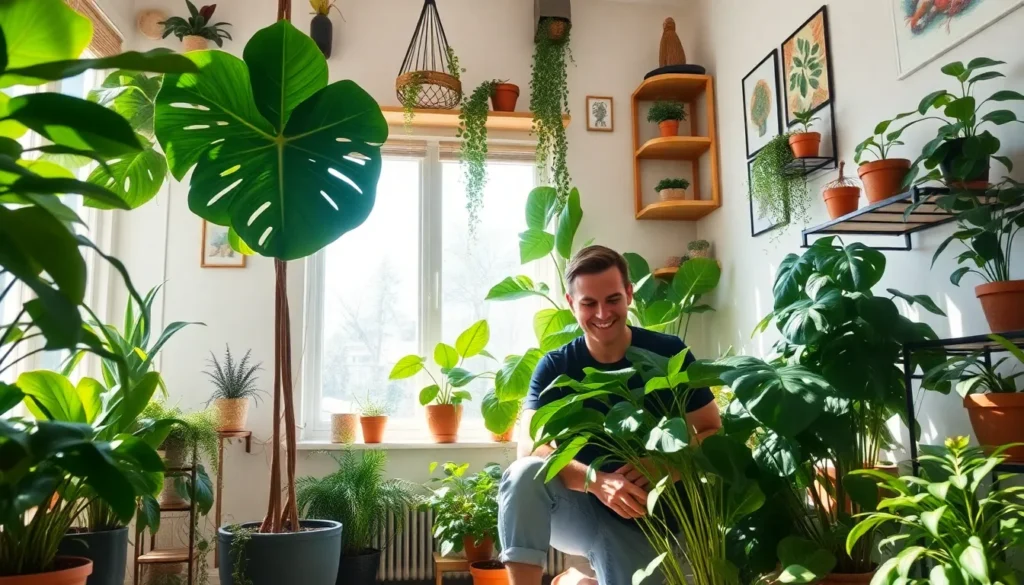We’ve all dreamed of transforming our living spaces into lush green sanctuaries, but creating a room full of plants can feel overwhelming without the right guidance. The good news? You don’t need a green thumb or endless hours to cultivate an indoor jungle that’ll make your friends envious.
Indoor plant rooms aren’t just Instagram-worthy – they’re proven mood boosters that purify your air while creating a calming retreat from daily stress. Whether you’re working with a sun-drenched living room or a cozy bedroom with limited light, we’ll show you exactly how to maximize your space for maximum greenery impact.
From selecting the perfect plant combinations to mastering maintenance routines that actually work, transforming any room into a botanical paradise is easier than you think. Let’s jump into the essential strategies that’ll help you create your own thriving plant haven.
Transform Your Living Space Into a Green Oasis With These Plant Room Ideas
Creating your own botanical paradise starts with smart plant selection and strategic placement. We’ll explore proven methods to turn any room into a thriving green sanctuary.
Choose the Right Plants for Your Space
Size considerations determine your plant room success. Large statement plants like fiddle leaf figs or monstera deliciosas work best in spacious areas with high ceilings. Medium rooms benefit from combining 3-4 mid-sized plants such as snake plants, peace lilies, or rubber trees. Compact spaces require smaller varieties including pothos, spider plants, and succulents.
Growth patterns affect long-term room dynamics. Climbing plants like golden pothos and philodendrons use vertical wall space effectively. Trailing varieties including string of hearts and Boston ferns create natural cascading effects from shelves or hanging planters. Upright growers such as ZZ plants and cast iron plants maintain compact footprints while adding substantial green coverage.
Maintenance requirements match your lifestyle commitments. Low-maintenance options including snake plants, ZZ plants, and pothos thrive with minimal weekly attention. Moderate-care plants like monstera and fiddle leaf figs need consistent watering and occasional fertilizing. High-maintenance varieties such as calatheas and orchids require daily monitoring and exact humidity levels.
Consider Light Requirements and Room Conditions
Natural light availability dictates plant placement success. South-facing windows provide intense direct sunlight perfect for sun-loving plants like succulents, cacti, and crotons. East and west-facing windows offer moderate indirect light suitable for most houseplants including snake plants, pothos, and rubber trees. North-facing rooms require low-light specialists such as ZZ plants, cast iron plants, and Chinese evergreens.
Humidity levels impact plant health dramatically. Bathrooms and kitchens naturally provide higher humidity perfect for tropical plants like ferns, calatheas, and air plants. Living rooms and bedrooms typically maintain moderate humidity suitable for most common houseplants. Dry rooms with heating or air conditioning require humidity-loving plants paired with humidifiers or pebble trays.
Temperature stability ensures consistent plant growth. Most houseplants thrive in temperatures between 65-75°F with minimal fluctuations. Avoid placing plants near heating vents, air conditioning units, or drafty windows. Tropical varieties need consistently warm conditions above 60°F while some succulents tolerate cooler temperatures down to 50°F.
Plan Your Layout for Maximum Visual Impact
Vertical arrangements create stunning green walls. Wall-mounted planters, floating shelves, and tall plant stands maximize floor space while adding dramatic height. Layer plants at different elevations using 2-3 height levels to create depth and visual interest. Hanging planters from ceiling hooks add another dimension without consuming valuable surface area.
Color coordination enhances overall room aesthetics. Green foliage varieties in different shades create monochromatic sophistication when paired with white or neutral planters. Colorful plants like crotons, coleus, and flowering varieties add vibrant accent points throughout the space. Metallic planters in gold, copper, or silver complement both modern and traditional room decor.
Grouping strategies amplify plant room impact. Odd-numbered clusters of 3-5 plants create natural, organic arrangements that feel intentional yet relaxed. Mix plant sizes within each grouping using one large anchor plant surrounded by smaller companions. Space multiple groupings throughout the room to distribute green coverage evenly while maintaining clear walking paths.
Create a Jungle-Like Atmosphere With Large Statement Plants
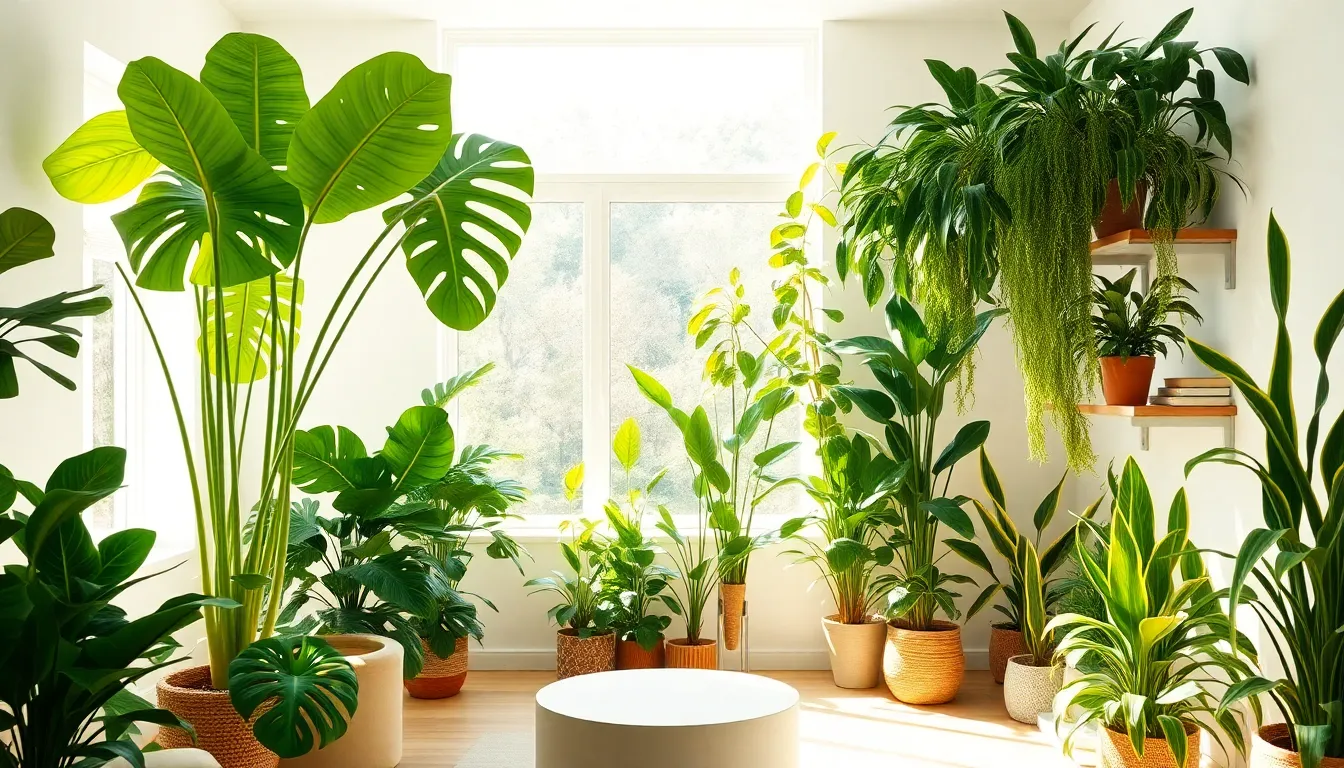
Large statement plants transform any room into a lush tropical paradise by adding dramatic height and bold foliage. We can create layers of texture and visual depth by strategically combining different species that bring the wild beauty of nature indoors.
Use Fiddle Leaf Figs as Dramatic Focal Points
Fiddle Leaf Figs (Ficus lyrata) serve as striking centerpieces with their oversized, violin-shaped leaves that command attention in any space. We position these architectural beauties near windows where they’ll receive ample natural light, allowing their glossy foliage to become living artwork. Their tall, sculptural form fills empty corners while softening harsh angles and adding instant sophistication to rooms.
Versatility makes these plants perfect for various decor styles, from modern minimalist to cozy farmhouse aesthetics. We can place them in living rooms, bedrooms, dining areas, or home offices to create vertical interest and natural elegance. Their large leaves draw the eye upward, making ceilings appear higher while establishing a bold foundation for our jungle themed room design.
Add Monstera Deliciosa for Tropical Vibes
Monstera Deliciosa brings unmistakable tropical flair with its iconic split and perforated leaves that create stunning visual patterns. We love how these dramatic fenestrations develop as the plant matures, adding exotic character that instantly transports us to a rainforest setting. Their sprawling growth habit fills horizontal space beautifully, creating lush backdrops behind furniture or along walls.
Easy care requirements make Monstera plants ideal for busy plant parents who want maximum impact with minimal fuss. We can train them up moss poles or let them cascade from elevated surfaces, adding movement and organic flow to our jungle atmosphere. Their bold, glossy foliage pairs perfectly with other tropical plants while creating depth and layering throughout the space.
Incorporate Tall Snake Plants for Vertical Interest
Snake Plants (Sansevieria) provide essential vertical structure with their upright, sword-like leaves that reach toward the ceiling. We use these architectural plants to create height variation and contrast against the broad, spreading foliage of Fiddle Leaf Figs and Monsteras. Their striking vertical lines add geometric interest while maintaining the natural jungle aesthetic.
Hardy adaptability allows Snake Plants to thrive in various lighting conditions, making them perfect for filling darker corners or areas with indirect light. We position them strategically to guide the eye around the room and create natural room dividers. Their low maintenance nature and air purifying qualities make them essential building blocks for creating a vibrant, jungle-like environment that feels both wild and welcoming.
Maximize Your Space With Strategic Plant Placement Techniques
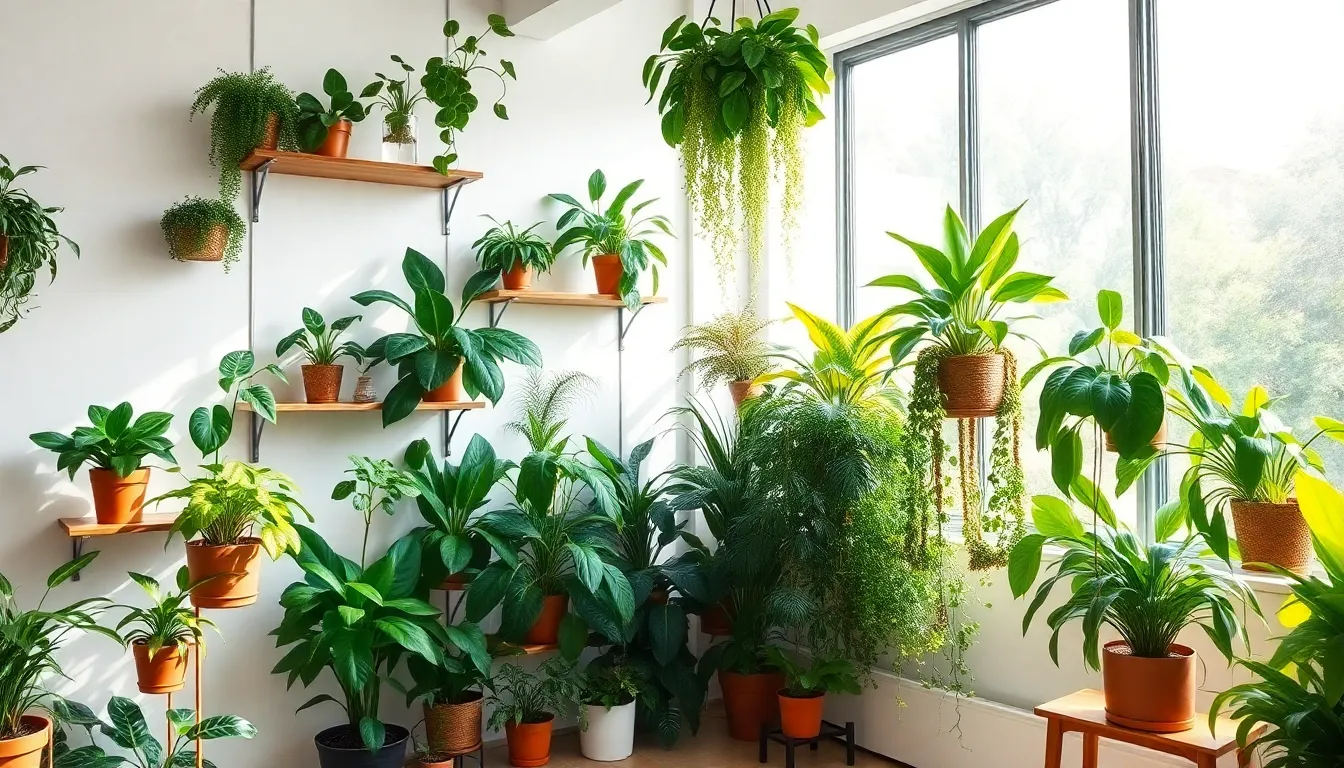
We can transform any room into a lush botanical paradise by implementing smart placement strategies that make the most of every square foot. Strategic positioning starts from the floor up, using larger plants like fiddle leaf figs or monsteras in corners or as natural room dividers.
Use Hanging Planters for Ceiling Gardens
Hanging planters free up valuable floor and surface space while creating stunning aerial displays. Trailing plants, moss balls, and lightweight plant varieties work exceptionally well for these elevated gardens, bringing greenery to eye level and above. We recommend positioning these hanging displays near windows where they’ll receive adequate light without blocking natural illumination for other plants below. Ceiling mounted planters add vertical dimension to our plant collections, making rooms feel fuller without cluttering surfaces.
Install Wall-Mounted Shelves for Vertical Growing
Wall-mounted shelves unlock vertical growing potential, especially crucial for smaller rooms where floor space is limited. These shelving systems allow us to layer plants at different heights, combining trailing species with upright varieties for maximum visual impact. We can create dramatic living walls or plant art installations using floating shelves positioned at varying levels. Staggered shelf arrangements work particularly well for displaying collections of smaller plants like pothos, philodendrons, and succulents while keeping them accessible for maintenance.
Group Plants at Different Heights for Depth
Creating clusters of plants across multiple levels introduces compelling visual interest and natural depth to our spaces. We achieve this layered effect by placing plants on floors, tables, shelves, and hanging from ceilings simultaneously. Varying pot sizes and plant heights engages the eye, making our collections feel lush and naturally abundant rather than uniform or cluttered. Grouping plants in odd numbers, particularly threes, near similar light conditions improves both harmony and practical care routines while creating more ever-changing visual arrangements.
Design a Plant-Filled Room That Improves Air Quality and Wellness
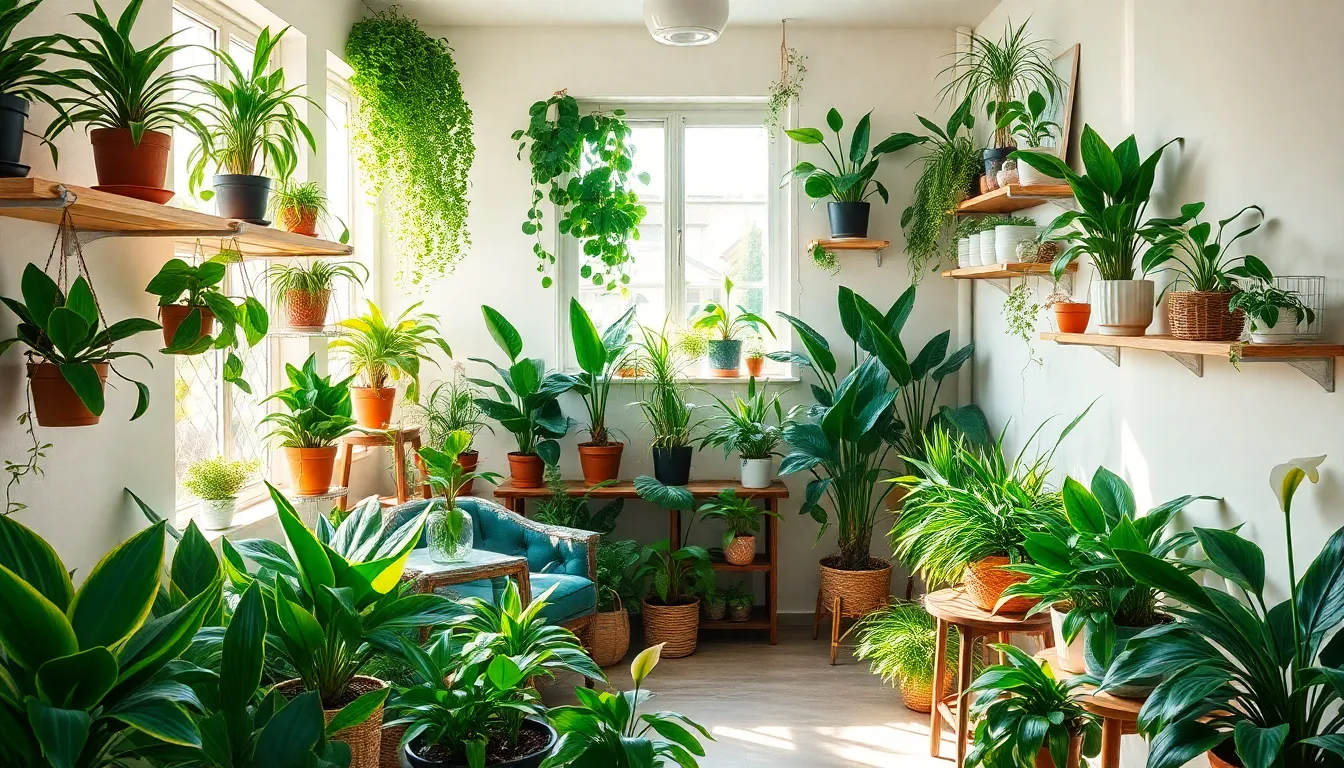
Creating a botanical sanctuary goes beyond aesthetics—it’s about transforming your space into a health-promoting environment. Strategic plant selection and placement can actively clean your air while boosting your physical and mental wellbeing.
Select Air-Purifying Plants for Health Benefits
NASA’s groundbreaking research reveals that indoor plants actively remove common pollutants like formaldehyde, benzene, and xylene through natural biological processes including photosynthesis and transpiration. Snake plants excel at filtering toxins while requiring minimal care, making them perfect for beginners. Spider plants multiply quickly and effectively absorb harmful chemicals from household items and furniture.
Peace lilies combine air purification with elegant white blooms that signal when they need water. Pothos vines cascade beautifully while working overtime to clean your indoor air. These plants don’t just look good—they’re actively working to reduce indoor air pollution levels.
Keep in mind that effectiveness requires substantial plant density, with hundreds of plants needed per typical home to match mechanical purifiers. We recommend starting with these proven air cleaners and gradually building your collection for maximum health benefits.
Create Humidity Zones for Plant and Human Comfort
Plants naturally release water vapor during transpiration, increasing indoor humidity levels that benefit both you and your green companions. Ferns thrive in grouped arrangements where they can share moisture and create their own microclimate. Palms work similarly, preferring the company of other humidity-loving species.
Grouping these moisture-loving plants together creates beneficial humidity zones that improve respiratory comfort and alleviate dry skin. Position your humidity zone near seating areas where you’ll spend time reading or relaxing. This natural humidification process is particularly valuable in dry environments or during winter months when heating systems reduce indoor moisture.
Boston ferns and bird’s nest ferns make excellent humidity zone anchors, while areca palms add height and tropical appeal to your moisture-rich microclimate.
Position Plants to Reduce Stress and Boost Mood
Strategic placement in high-activity areas like offices, bedrooms, and living rooms maximizes plants’ psychological benefits. Research shows that plants reduce stress, lower blood pressure, and improve mood while improving mental clarity and productivity. Desk plants like small pothos or snake plants provide immediate stress relief during work hours.
Bedroom plants such as peace lilies or spider plants contribute to better sleep quality while purifying overnight air. Position larger statement plants where you’ll see them frequently—their visual presence provides calming, natural aesthetics that reduce mental fatigue.
Living room arrangements benefit from varied heights and textures that create visual interest while boosting creativity. The natural beauty of plants complements any decor style while delivering unique wellness benefits that mechanical air purifiers simply can’t match.
Style Your Room Full of Plants With Decorative Containers and Accessories
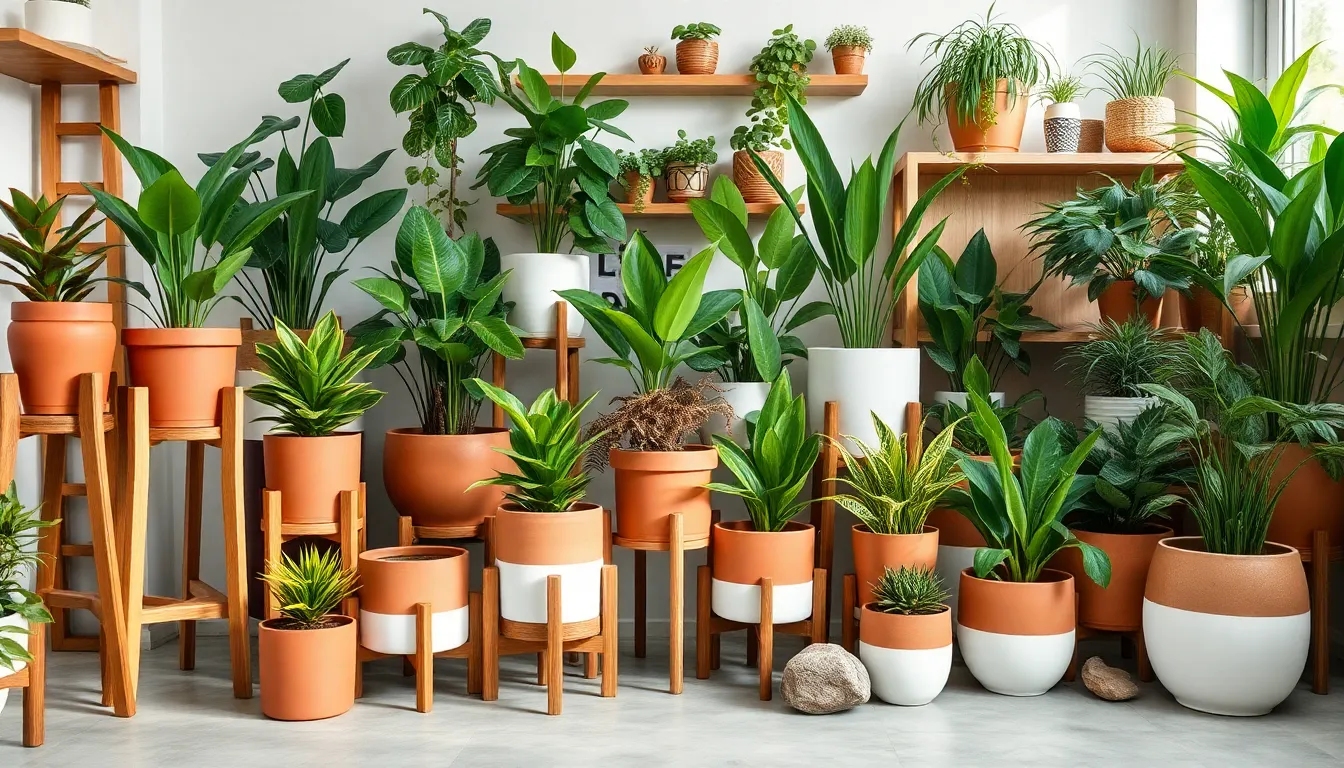
After establishing our botanical sanctuary with strategic placement and health benefits, we can elevate the aesthetic appeal through thoughtful styling choices. The right decorative elements transform a simple plant collection into a cohesive, professional-looking indoor garden.
Choose Coordinating Planters for Visual Cohesion
Coordinated containers create the foundation for a polished plant room design. We recommend selecting pots and planters that share common elements like color palettes, materials, or design styles rather than mixing random containers. Neutral tones such as terracotta, white ceramic, or natural wicker work particularly well because they complement various plant colors without competing for attention.
Material consistency strengthens the overall visual impact. Choosing planters made from similar materials like glazed ceramics, natural fiber baskets, or metal containers helps unify the space. We’ve found that grouping three to five coordinated planters together creates more dramatic focal points than scattering individual pots throughout the room.
Size variation within the same style family adds ever-changing interest. Different sized containers in matching styles prevent the display from looking monotonous while maintaining cohesion. This approach works especially well when we group plants with similar care requirements like tropical aroids including Monstera and Anthurium together.
Add Plant Stands and Decorative Supports
Plant stands create essential vertical layers that maximize display space. We use stands of varying heights to position plants at different eye levels, which makes the room feel more ever-changing and prevents flat, one-dimensional arrangements. Wooden plant stands, metal tiered displays, and decorative pedestals work particularly well for this purpose.
Macramé hangers and decorative supports add textural diversity. These elements help us use ceiling space while introducing organic shapes and patterns that complement the natural plant forms. Trellises and climbing supports also serve dual purposes by providing structure for vining plants while contributing to the room’s decorative appeal.
Strategic placement of supports enhances both function and aesthetics. We position taller stands near corners or against walls to create backdrop layers, while shorter stands work well for tabletops and surface displays. This tiered approach ensures every plant receives proper visibility while contributing to the overall room composition.
Incorporate Natural Elements Like Wood and Stone
Natural materials enhance the organic atmosphere of plant filled spaces. Wooden shelves, stone planters, and pebble trays create seamless connections between our plant collection and natural design elements. These materials add warmth and texture that synthetic alternatives simply can’t match.
Stone accents provide grounding elements for lighter plant displays. We incorporate stone planters, river rock drainage trays, and decorative pebbles to add weight and stability to our arrangements. These elements work particularly well with larger floor plants like Fiddle Leaf Figs, Rubber Trees, and Areca Palms that need substantial visual anchoring.
Wood textures bring warmth and complement various plant types. Natural wood plant stands, floating shelves, and decorative branches create perfect backdrops for green foliage. We’ve discovered that mixing different wood tones adds depth without creating visual chaos, especially when we maintain consistent planter styles throughout the display.
Maintain Your Indoor Plant Paradise With Proper Care Routines
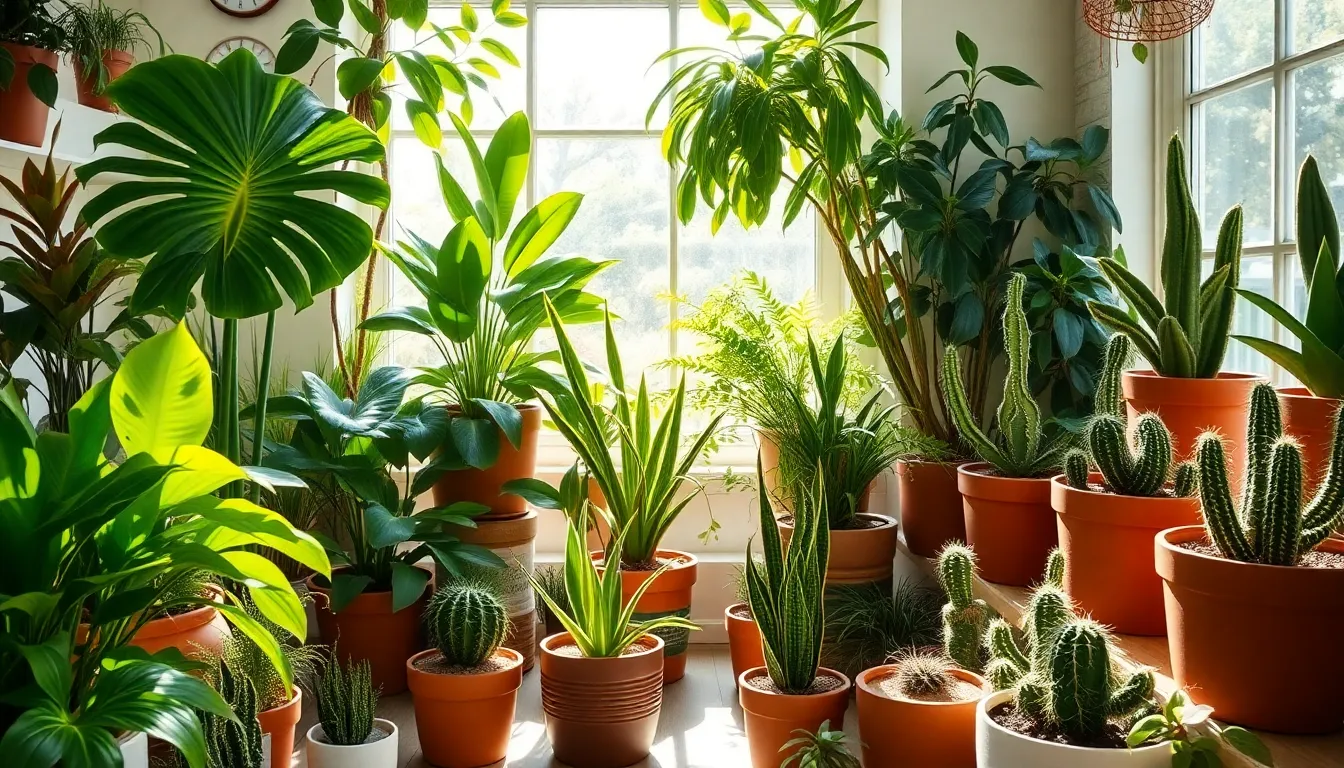
Once you’ve transformed your space into a lush botanical sanctuary, consistent care routines become essential for keeping your plant paradise thriving. Proper maintenance ensures your green oasis continues to purify air and enhance your living environment.
Establish Watering Schedules for Different Plant Types
Creating customized watering schedules prevents the most common plant care mistakes. Different species require varying moisture levels, so we recommend identifying each plant type to determine appropriate watering frequency. Overwatering causes root rot in most houseplants, while underwatering leads to drooping or yellowing leaves that compromise your plant’s health.
Keep potting soil consistently moist but never soggy. We suggest checking soil moisture by inserting your finger about an inch deep into the soil before watering. Ensure all pots have proper drainage holes to prevent water accumulation that can damage root systems.
Develop a weekly routine that accounts for seasonal changes. Most tropical plants like Monstera and Fiddle Leaf Figs need more frequent watering during spring and summer growing seasons. Desert plants such as succulents and cacti require water only when soil becomes completely dry, typically every 2-3 weeks.
Provide Adequate Lighting Answers
Assess your room’s natural light conditions before supplementing with artificial options. We recommend observing how sunlight moves through your space throughout the day to identify bright spots and shadowy areas where different plants can thrive.
Position low light plants like ZZ plants and peace lilies in areas with minimal natural light. These varieties flourish in indirect sunlight and can benefit from artificial grow lights placed near north facing windows. Snake plants also adapt well to lower light conditions while maintaining their air purifying qualities.
Place bright light plants such as succulents and cacti where they’ll receive several hours of direct sunlight. We suggest rotating these plants weekly to ensure even growth patterns. But, monitor for leaf scorch during intense summer months and provide shade protection when necessary.
Install full spectrum LED grow lights for rooms with limited natural light. Position these lights 12-24 inches above plant canopies and run them for 12-16 hours daily to supplement inadequate window light.
Monitor for Pests and Plant Health Issues
Conduct weekly inspections to catch problems before they spread throughout your plant collection. We recommend examining leaves, stems, and soil surfaces for signs of common indoor pests like spider mites, aphids, or fungus gnats that can quickly infest multiple plants.
Watch for yellowing leaves that often indicate overwatering or nutrient deficiency issues. Brown leaf tips typically signal low humidity levels or excess fertilizer buildup in the soil. Drooping leaves usually result from underwatering or temperature stress affecting plant vitality.
Address health problems immediately using targeted answers. Remove affected leaves promptly to prevent disease spread, adjust watering schedules based on observed symptoms, and isolate infected plants until treatment resolves the issue. Natural pest control methods like neem oil or insecticidal soap effectively treat most common houseplant pests without harsh chemicals.
Track each plant’s exact needs using a personalized care guide. Document watering dates, fertilization schedules, and any health observations to optimize your maintenance routine over time and ensure your indoor plant paradise continues flourishing.
Conclusion
Creating our own room full of plants transforms more than just our living space—it revolutionizes how we experience our home environment. We’ve explored everything from strategic plant selection to styling techniques that turn any room into a thriving botanical sanctuary.
The journey from empty corners to lush green spaces doesn’t require expertise or massive time investment. With the right approach to placement lighting and care routines we can build an indoor oasis that delivers both stunning visual appeal and measurable health benefits.
Our plant-filled rooms become living ecosystems that purify air reduce stress and create natural focal points throughout our homes. By following these proven strategies we’re not just decorating—we’re investing in our wellbeing and creating spaces that truly nurture both body and mind.
Frequently Asked Questions
What are the main benefits of creating an indoor plant haven?
Indoor plants offer multiple benefits including improved air quality, enhanced mood, and stress reduction. They actively remove pollutants from the air while adding natural beauty to your living space. Plants also increase humidity levels and create a calming atmosphere that can boost productivity and overall well-being.
Do I need gardening experience to create an indoor plant sanctuary?
No, you don’t need extensive gardening skills or significant time investment. Anyone can successfully transform their living space into a plant haven by choosing the right plants for their environment and following basic care guidelines. Start with low-maintenance plants and gradually build your collection.
Which plants work best for beginners in indoor gardening?
Snake Plants are excellent for beginners due to their adaptability and air-purifying qualities. Peace Lilies are also great choices as they remove indoor pollutants effectively. These plants are forgiving with watering schedules and can tolerate various light conditions, making them perfect for new plant parents.
How should I arrange plants for maximum visual impact?
Group plants in odd numbers and vary pot sizes to create visual interest. Use vertical arrangements with hanging planters and wall-mounted shelves to maximize space. Position larger statement plants like Fiddle Leaf Figs or Monstera Deliciosa in corners or near windows as dramatic focal points.
What’s the best way to coordinate planters and accessories?
Choose neutral tones and maintain material consistency for a polished, cohesive look. Use plant stands and decorative supports to add vertical layers and enhance visibility. Incorporate natural elements like wood and stone to add warmth and texture, transforming your collection into a professional-looking indoor garden.
How do I maintain proper care routines for multiple plants?
Establish customized watering schedules based on each plant’s specific needs to prevent overwatering. Monitor natural light conditions and supplement with artificial lighting when necessary. Conduct regular inspections for pests and health issues, and document care routines to track what works best for each plant.
Can indoor plants really purify the air in my home?
Yes, certain plants like Snake Plants and Peace Lilies actively remove indoor pollutants and improve air quality. However, substantial plant density is necessary for effective air purification. These plants offer unique wellness benefits that mechanical air purifiers cannot match, including psychological benefits and improved humidity levels.
How can I maximize space in a small room with plants?
Use strategic placement techniques like positioning larger plants in corners or as natural room dividers. Install hanging planters for aerial displays and wall-mounted shelves for vertical growing. Layer plants at different heights to create depth and visual interest while making the most of limited floor space.

